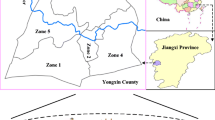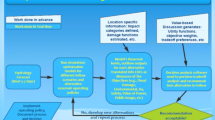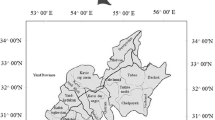Abstract
Water resources planning and management are plagued with various uncertainties in that any chosen management alternative always has the possibility to be inferior to other competing alternatives. To facilitate risk-based decision making, the minimax expected opportunity loss (EOL) rule is applied for alternative selection. Two existing risk measures as well as EOL are compared and their implications in risk-based decision making are examined. It is shown that EOL can reflect more accurately the relative merit of two competing alternatives without suffering the pessimism and the counter-intuition of the other two risk measures considered herein. The minimax EOL rule is demonstrated through an application to a river basin management decision for improving the navigation. The results show that the correlation between outcomes of competing alternatives and decision maker’s acceptable risk are important in decision making under uncertainty.



Similar content being viewed by others
References
Apostolakis GE (2004) How useful is quantitative risk assessment? Risk Anal 24:515–520
Bawa VS, Lindenberg EB (1977) Capital market equilibrium in a mean-lower partial moment framework. J Financ Econ 5:189–200. doi:10.1016/0304-405x(77)90017-4
Bender MJ, Simonovic SP (2000) A fuzzy compromise approach to water resource systems planning under uncertainty. Fuzzy Sets Syst 115:35–44. doi:10.1016/S0165-0114(99)00025-1
Bonini CP (1975) Risk evaluation of investment projects. Omega 3:735–750. doi:10.1016/0305-0483(75)90075-4
Castro JL, Navarro M, Sanchez JM, Zurita JM (2009) Loss and gain functions for CBR retrieval. Inf Sci 179:1738–1750. doi:10.1016/j.ins.2009.01.017
Christoffersen PF (2003) Elements of Financial Risk Management. Academic, Amsterdam, Boston
de Kort IAT, Booij MJ (2007) Decision making under uncertainty in a decision support system for the Red River. Environmental Modelling &. Software 22:128–136. doi:10.1016/j.envsoft.2005.07.014
Despic O, Simonovic SP (2000) Aggregation operators for soft decision making in water resources. Fuzzy Sets Syst 115:11–33. doi:10.1016/S0165-0114(99)00030-5
Duchesne S, Beck MB, Reda ALL (2001) Ranking stormwater control strategies under uncertainty. The River Cam case study Water Sci Technol 43:311–320
Estrada J (2007) Mean-semivariance behavior: downside risk and capital asset pricing. International review of economics &. Finance 16:169–185. doi:10.1016/j.iref.2005.03.003
Hadar J, Russell WR (1969) Rules for ordering uncertain prospects. Am Econ Rev 59:25–34
Hanoch G, Levy H (1969) The efficiency analysis of choices involving risk. Rev Econ Stud 36:335–346
Jenkins MW, Lund JR (2000) Integrating yield and shortage management under multiple uncertainties. J Water Resour Plann Manage 126:288–297
Kangas J, Store R, Leskinen P, Mehtätalo L (2000) Improving the quality of landscape ecological forest planning by utilising advanced decision-support tools. For Ecol Manag 132:157–171. doi:10.1016/s0378-1127(99)00221-2
Kaplan S, Garrick BJ (1981) On the quantitative definition of risk. Risk Anal 1:11–27. doi:10.1111/j.1539-6924.1981.tb01350.x
Markowitz HM (1952) Portfolio selection. J Financ 7:77–91
Melching CS, Yoon CG (1996) Key sources of uncertainty in QUAL2E model of Passaic river. J Water Resour Plann Manage 122:105–113
Miser HJ, Quade ES (1985) Handbook of systems analysis : overview of uses, procedures, applications, and practice. North-Holland, New York
Park CS, Sharp-Bette GP (1990) Advanced engineering economics. Wiley, New York
Parmigiani G, Inoue LYT (2009) Decision Theory: Principles and Approaches. Wiley series in probability and statistics. John Wiley & Sons, Chichester, West Sussex, U.K.; Hoboken, N.J.
Porter RB, Carey K (1974) Stochastic dominance as a risk analysis criterion. Decis Sci 5:10–21
Quirk JP, Saposnik R (1962) Admissibility and measurable utility functions. Rev Econ Stud 29:140–146
Roy AD (1952) Safety first and the holding of assets. Econometrica 20:431–449
Schoustra F, Mockett I, van Gelder P, Simm J (2004) A new risk-based design approach for hydraulic engineering. J Risk Res 7:581–597
Simonović SP (2012) Floods in a Changing Climate: Risk Management [electronic resource]./Slobodan P. Simonović. International Hydrology Series. Cambridge : Cambridge University Press, 2012,
Stewart MG, Rosowsky DV, Val DV (2001) Reliability-based bridge assessment using risk-ranking decision analysis. Struct Saf 23:397–405
Su H-T, Tung Y-K (2013) Flood-damage-reduction project evaluation with explicit consideration of damage cost uncertainty. J Water Resour Plann Manage 139:704–711. doi:10.1061/(ASCE)WR.1943-5452.0000291
Teegavarapu RSV, Simonovic SP (1999) Modeling uncertainty in reservoir loss functions using fuzzy sets. Water Resour Res 35:2815–2823. doi:10.1029/1999wr900165
Tung Y-K (1987) Effects of uncertainties on optimal risk-based design of hydraulic structures. J Water Resour Plann Manage 113:709–722
Tung Y-K (1994) Probabilistic hydraulic design: a next step to experimental hydraulics. J Hydraul Res 32:323–336. doi:10.1080/00221689409498736
Tung Y-K (2005) Flood defense systems design by risk-based approaches. Water Int 30:50–57. doi:10.1080/02508060508691836
Tung Y-K, Wang P-Y, Yang J-C (1993) Water resource projects evaluation and ranking under economic uncertainty. Water Resour Manage 7:311–333. doi:10.1007/bf00872287
Tung Y-K, Yang J-C (1994) Probabilistic evaluations of economic merit of water resource projects. Water Resour Manage 8:203–223. doi:10.1007/bf00877087
Vreugdenhil CB (2006) Appropriate models and uncertainties. Coast Eng 53:303–310. doi:10.1016/j.coastaleng.2005.10.017
Walker WE, Harremoës P, Rotmans J, van der Sluijs JP, van Asselt MBA, Janssen P, Krayer von Krauss MP (2003) Defining uncertainty: a conceptual basis for uncertainty management in model-based decision support. Integr Assess 4:5–17. doi:10.1076/iaij.4.1.5.16466
Whitmore GA (1970) Third-degree stochastic dominance. Am Econ Rev 60:457–459
Xu Y-P, Tung Y-K (2008) Decision-making in water management under uncertainty. Water Resour Manage 22:535–550. doi:10.1007/s11269-007-9176-x
Xu YP (2005) Appropriate modelling in decision support systems for river basin management. Ph.D. Thesis, University of Twente
Xu YP, Tung YK (2009) Decision rules for water resources management under uncertainty. J Water Resour Plann Manage 135:149–159
Xu YP, Tung YK, Li J, Niu SF (2009) Alternative risk measure for decision-making under uncertainty in water management. Prog Nat Sci 19:115–119
Zadeh LA (1965) Fuzzy sets. Information and control 8:338-353 doi:http://dx.doi.org/10.1016/S0019-9958 (65) 90241-X
Acknowledgments
The study is supported by Hong Kong Research Grant Council for the project 620608 ‘Application of risk-based approach to hydrosystems.’
Author information
Authors and Affiliations
Corresponding author
Rights and permissions
About this article
Cite this article
SU, HT., Tung, YK. Comparisons of Risk-based Decision Rules for the Application of Water Resources Planning and Management. Water Resour Manage 28, 3921–3935 (2014). https://doi.org/10.1007/s11269-014-0718-8
Received:
Accepted:
Published:
Issue Date:
DOI: https://doi.org/10.1007/s11269-014-0718-8




